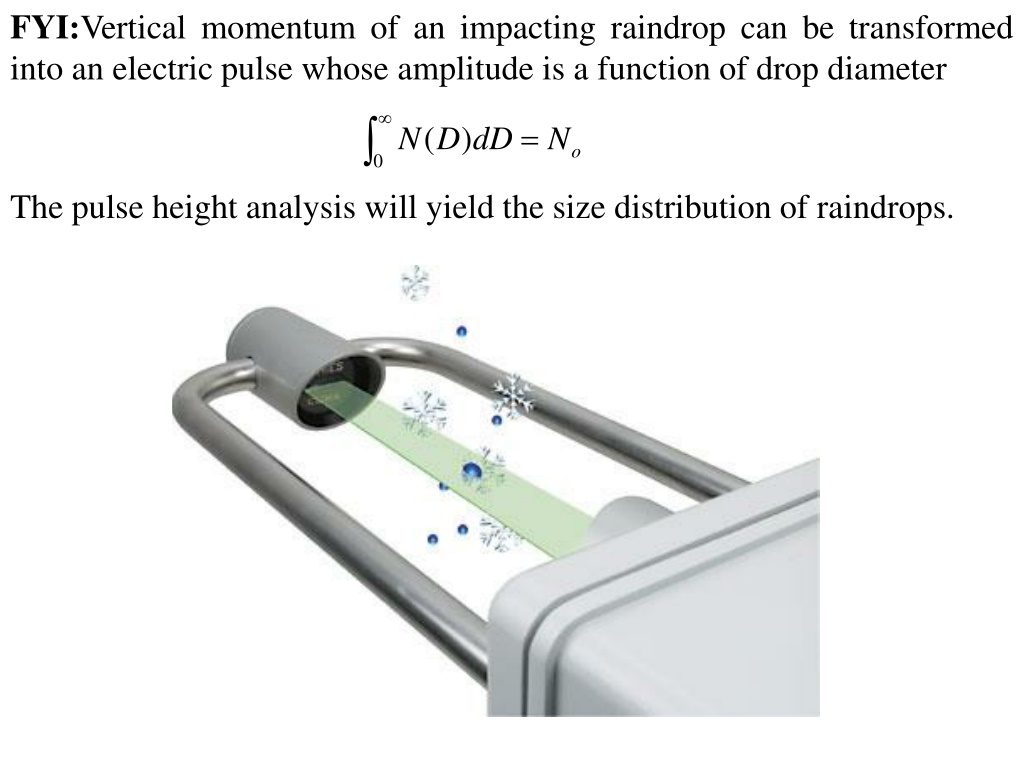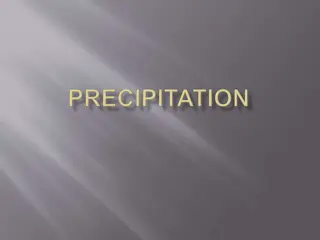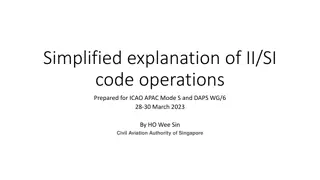Insights into Raindrop Size Distribution and Precipitation Intensity through Radar Technology
Vertical momentum of impacting raindrops can be converted into an electric pulse to analyze raindrop size distribution. Disdrometers using video cameras can directly count raindrops for sizing. Radar technology provides superior data on precipitation accumulation and intensity by measuring radar reflectivity. The Z-R relationship explains the sensitivity of precipitation intensity to drop diameter variations.
Download Presentation

Please find below an Image/Link to download the presentation.
The content on the website is provided AS IS for your information and personal use only. It may not be sold, licensed, or shared on other websites without obtaining consent from the author. Download presentation by click this link. If you encounter any issues during the download, it is possible that the publisher has removed the file from their server.
E N D
Presentation Transcript
FYI:Vertical momentum of an impacting raindrop can be transformed into an electric pulse whose amplitude is a function of drop diameter 0 The pulse height analysis will yield the size distribution of raindrops. = ( ) N D dD N o
Another type of disdrometers uses a video camera to directly count drops to give distribution of rain droplets N (D) or number density of the drops, so that rain droplets can be sized. This disdrometer uses two, side video to record optical images of each raindrop.
Remote Sensing of QPE Precipitation accumulation is routinely derived from radar and satellite observations. Despite the inconsistencies (conflicts) in radar-derived precipitation from location to location and from season to season, radar guidance is considered superior to satellite guidance of QPE in many areas. This is mainly due to the superior resolution in both space and time and often better quantitative guidance. Precipitation radar Weather radars are both transmitters and receivers, transmit a microwave beam and then "listen" for echoes that bounce back from precipitation- sized particles (or "targets") within or falling from clouds. Since we know both the direction in which the radar transmitter is pointing and the speed at which microwaves travel (close to the speed of light), the direction and distance from the transmitter to the precipitation can be determined. This permits mapping of precipitation over the region surrounding the radar site.
Precipitation intensity can be determined by measuring the strength of the echoes received by the radar antenna. The amount of energy reflected back to the radar is proportional to the precipitation intensity the greater the energy reflected back to the radar, the greater the precipitation intensity . Radar reflectivity (Z), expressed in units of dBZ, is used to compute rainfall rates (R) in mm/h using a reflectivity to rainfall rate relationship. This is known as the Z-R relationship. Rainfall rates then get integrated over time to produce accumulation for various time periods. Z = reflectivity factor D = drop diameter N(D) = number of drops of given diameter per cubic meter = 3 6 ( ) ( ) ( ) Z N D D V D N D D This gives us a Z-R relationship; and it is presented to explain the sensitivity of reflectivity factor, Z, to drop diameter. Because the drop diameter is raised to the 6th power, small changes in drop diameter result in very large changes to Z. And large changes to Z result in large changes to derived rainfall rates.
Z-R varies with type of rain. There were 69 Z-R relationships, and the average Z-R relationship of all of them is Z = 6 . 1 200R The relationship between reflectivity and rainfall rate, and thus the Z-R relationship, varies with time, location, and season. Hydrometeor properties that influence the Z-R relationship include size, concentration, and phase. Accuracy of derived rainfall rates is further impacted by the presence of non-hydrometeors, and whether the radar is sampling a region that is representative of precipitation reaching the ground.
Doppler precipitation radar Doppler radar is radar that makes use of the Doppler Effect, is the change in frequency of a wave for an observer moving relative to the source of the waves. The same effect takes place in the atmosphere as a pulse of energy (a microwave signal) from a radar strikes an object and is reflected back toward the radar. The radar measures the phase change of the reflected pulse of energy, which is then converted to the velocity of the object, either toward or from the radar.
Measuring precipitation from space Rainfall can be inferred from the temperature of cloud tops. Microwave radiation emitted by clouds can be used to discern rainfall intensity. For TRMM, a weather radar can transmit a beam of microwave energy downward inside clouds; the energy scattered back to the radar by raindrops provides information on rain intensity and its vertical distribution Tropical Rainfall Measuring Mission (TRMM) was launched by the National Aeronautics and Space Administration (NASA) and the National Space Development Agency of Japan (NASDA). TRMM was the first satellite dedicated to rainfall measurement, and is the only satellite that carries a weather radar until recently launched CloudSat/CALIPSO (the Cloud- Aerosol Lidar and Infrared Pathfinder Satellite Observation).
TRMM has a limited view of the Earth, ranging from 36 N to 36 S, and samples rain relatively infrequently, passing over the same location about once a day. TRMM is insensitive to light rainfall. Also, cloud top temperatures are imperfectly correlated with actual rainfall reaching the surface.
Satellite QPE Satellite estimation of precipitation is potentially useful in areas with poor coverage from radars and rain gauges. Although satellite sampling is more consistent from place to place than radar sampling, satellite- derived precipitation is lower resolution and generally less accurate than radar-derived precipitation. It is therefore considered a supplement, not a replacement for the radar products.























